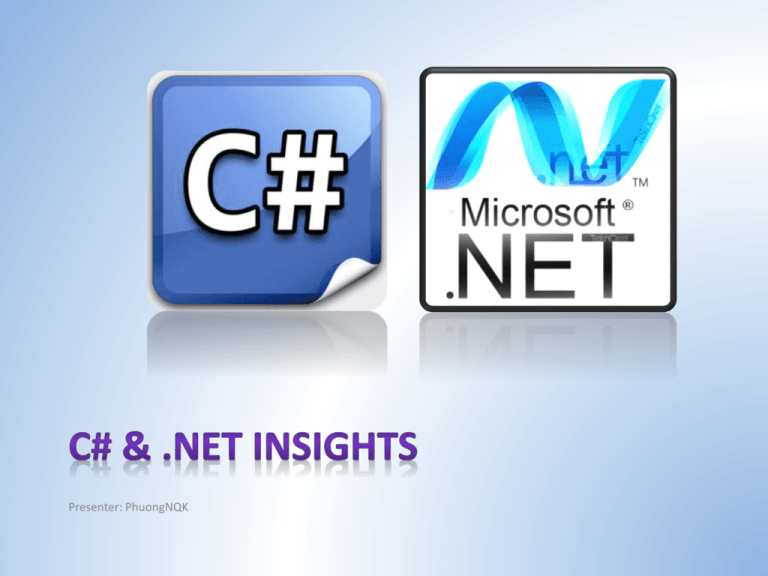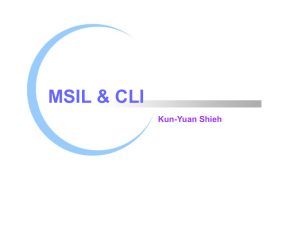LINQ
advertisement

Presenter: PhuongNQK Goals • Provide you insights into core concepts of .NET framework Assembly Application domain MSIL .NET Framework Overview .NET framework SDK C# VB.NET F# Managed C++ J# Common Language Specification (CLS) … Common Type System (CTS) .NET framework redistributable .NET Framework Class Library (FCL) ASP.NET Windows Forms WPF WCF & WWF (Communication & Workflow) ADO.NET, LINQ, XML Base Class Library (BCL) Common Language Runtime (CLR) Operating System Silverlight Visual Studio .NET .NETf libraries C#, CLR & .NETf versions What’s new in .NETf 4.0? What’s new in .NETf 4.5? .NET core concepts • Assembly • Application domain • MSIL Assembly • Self-describing unit of deployment Comprise 1 single Windows PE file • .exe (application) – defines 1 entry point • .dll (reusable library) • .winmd (WinRT library – contains only metadata) Contain metadata • Container for all types • A boundary for type resolution and security permissioning Assembly content • • • • Assembly manifest (info to .NET) – REQUIRED Application manifest (info to OS) Compiled types (IL code + metadata) Resources, e.g. images, localizable text Assembly manifest Functional data Informational data • • • • • • • • • The simple name of the assembly A version number (AssemblyVersion) A public key and signed hash of the assembly, if strongly named A list of referenced assemblies, including their version and public key A list of modules that comprise the assembly A list of types defined in the assembly and the module containing each type An optional set of security permissions requested or refused by the assembly (SecurityPermission) The culture it targets, if a satellite assembly (AssemblyCulture) • • • A full title and description (AssemblyTitle and AssemblyDescription) Company and copyright info (AssemblyCompany and AssemblyCopyright) A display version (AssemblyInformationalVersion) Additional attributes for custom data AssemblyXXXAttribute classes Application manifest • Read and processed before the .NET-managed hosting environment loads the assembly • Can influence how OS launches app’s process Metro applications have a far more elaborate manifest, described in the Package.appxmanifest file. This includes a declaration of the program’s capabilities, which determine permissions granted by OS. Application manifest • How to deploy As a specially named file located in the same folder as the assembly • MyApp.exe -> MyApp.exe.manifest Embedded within the assembly itself • mt -manifest MyApp.exe.manifest -outputresource:MyApp.exe;#1 Assembly types • Single file vs. Multi-file • Main vs. Satellite • Private vs. Shared Single-file assembly Multi-file assembly Multi-file assembly Main vs. Satellite assemblies Private assembly • • • • Also called weakly-named assembly Usable by a single app An assembly is private by default A private assembly can reference any other assembly Shared assembly • Also called strongly-named assembly • Must have An assembly name A version A public key • Reside in GAC, hence sharable between apps • Multiple versions can co-exist side-by-side • A shared assembly can only reference other shared assemblies How to create a shared assembly? • Generate a public/private key pair sn -k key.snk • Use the private key to sign the assembly • Install it to GAC (%Windows%\Microsoft.NET\assembly\) gacutil /i <assembly_path> Assembly references Private assembly Private assembly Shared assembly Shared assembly Private assembly Shared assembly Private assembly Shared assembly A\B x86 x86 x x64 Any x x64 x x Any x x A references B A bit on versioning Major Minor Build Revision Description 1 0 0 0 Original version 1 0 0 1 A revision (maybe a bugfix) 1 0 1 0 A new build 1 1 0 0 A new minor version 2 0 0 0 A new major version Note: - Default version is 0.0.0.0 - 2 incompatible versions have different major and/or minor values - <bindingRedirect> tells CLR to redirect references to a newer version - CLR performs version checking on shared assemblies only Signing assemblies Note: We can delay-sign an assembly. Assembly identity • Simple name Come from the name of the file to which it was originally compiled (less any extension). • E.g. System.Xml.dll -> System.Xml Not changed when the file is renamed • Version (“0.0.0.0” if not present) AssemblyVersion • Culture (“neutral” if not a satellite) AssemblyCulture • Public key token (“null” if not strongly-named) Key file Fully-qualified assembly name • simple-name, Version=version, Culture=culture, PublicKeyToken=public-key System.Xml, Version=2.0.0.0, Culture=neutral, PublicKeyToken=b77a5c561934e089 Q&A .NET core concepts • Assembly • Application domain • MSIL Application domain • The runtime unit of isolation in which a .NET program runs A managed memory boundary A container for loaded assemblies and app config settings A communication boundary for distributed apps • Each .NET process usually hosts just 1 app domain: the default domain, auto-created by CLR when the process starts • Can create 2+ app domains within the same process Isolation with less overhead and communication complications (compared to having n processes) Useful in scenarios such as load testing and app patching, and in implementing robust error recovery mechanisms • Win Metro apps can access to only 1 app domain App domain architecture App domain architecture App domain architecture Scenario - Problem • You’ve written a custom authentication system, and as part of unit testing, you want to stress-test the server code by simulating 20 clients logging in at once. • How will you simulate 20 clients? Scenario - Solutions • Start 20 separate processes by calling Process.Start() 20 times • Start 20 threads in the same process and domain • Start 20 threads in the same process—each in its own app domain Q&A .NET core concepts • Assembly • Application domain • MSIL .NET code lifecycle Managed language code (C#, VB.NET, F#, etc.) Normal language code (C++, VB, etc.) .NET compiler Normal compiler Managed code (MSIL) Generated during compile time CLR-JIT compiler Machine code (x86, x64) Generated during runtime Machine code (x86, x64) Compiler & Decompiler Managed language code file (.cs, .vb, etc.) Dotpeek Reflector csc, vbc Managed code file (.il) ildasm ilasm Assembly file (.exe, .dll, .mod) SmartAssembly Smart assembly file (.exe, .dll, .mod) Dynamic assembly • Namespace: System.Reflection.Emit • Types AssemblyBuilder ModuleBuilder TypeBuilder ILGenerator MethodBuilder DynamicMethod • http://blogs.msdn.com/b/haibo_luo/archive/2006/11/ 16/take-two-il-visualizer.aspx Q&A References • C# 5.0 in a Nutshell, by Joseph Albahari & Ben Albahari, O’Reilly • Microsoft .Net for Programmers, by Fergal Grimes, Manning For more, please visit: http://phuonglamcs.com/relax/presentations/




